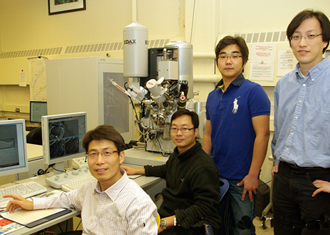L. Jay Guo Develops Coating for Radar-Invisible Paint
By wchung | 07 Dec, 2025
L. Jay Guo has used nanotubes to develop a coating to make military vehicles invisible to both the naked eye and to radar.
University of Michigan researcher L. Jay Guo has developed a coating that can be used to make military aircraft, tanks, ships and other vehicles completely invisible to radar.
Guo used carbon nanotubes to develop a coating that allows perfect absorption of electromagnetic energy ranging from long radio waves all the way through visible light to short UV light. This coating can be mixed into paint that can render any object completely invisible to both the naked eye and to enemy radar.
So far carbon nanotubes have attracted the attention of electrical engineers because they are perfectly conducting, allowing undreamed-of efficiencies in things like batteries and electronic circuitry. They have also won the favor of aeronautical and automotive engineers because they can be woven into material that is lighter and stronger than virtually any other. But L. Jay Guo is the first to recognize its energy-absorption property as promising an ideal material for stealthy coating.
To test his hunch Guo and his group grew long carbon nanotube straws vertically on the surface of various three-dimensional objects. The nanotubes made the surfaces of the objects perfect absorbers of light, making them completely black and invisible against a black background like a night sky. They showed the same effect on longer radio waves, neither scattering nor reflecting them because their index of refraction is virtually identical to the surrounding air. An aircraft coated with the nanotubes would appear not to be there to a radar operator.
Guo published the results of his experiments in the journal Applied Physics Letters.
Some work remains before Guo’s discovery can become a practical coating for stealthy military vehicles, however. The size of such objects make it impractical to grow nanotubes directly on their surfaces at the requisite high-temperature and high pressures. However, Guo believes the nanotubes can be grown on the surface of tiny particles which can be mixed into the paint to create similar energy-absorbing characteristics.
L. Jay Guo is a multi-disciplinary wonder. He is currently an associate professor of Electrical Engineering and Computer Science, Macromolecular Science and Engineering, and Applied Physics at the University of Michigan at Ann Arbor.
He received his B.S. in Biophysics from Nankai University, China in 1990, and his MS and Ph.D. in Electrical Engineering from the University of Minnesota in 1995 and 1997 respectively. He was a research associate at Princeton University from 1998-1999. He joined the Department of Electrical Engineering and Computer Science at the University of Michigan, Ann Arbor in 1999. Guo has served on many international conference program committees related to nanotechnologies and photonics and have given numerous invited talks. He also served as symposium chair of two MRS topical symposiums on printing methods for electronics, photonics, and biomaterials.
Guo heads up a lab at the UM with extensive experience in nanofabrication. Recently it has been focusing on developing continuous roll-to-roll nanoimprinting and nano-inscribing techniques for high-throughput fabrication of nanostructures with applications in nanophotonics, biosensors, and organic solar cells. His lab is also developing photonic microresonator based ultrasound detectors for high-resolution and high-sensitivity biomedical imaging application. It is also working on exploiting the plasmonic effect associated with metallic nanostructures for biosensing, contrast agents, semiconductor nanolaser, and for enhanced absorption in organic photovoltaics. Guo Lab has developed nanofluidic diodes that can rectify and regulate the ion flow in fluidic channels.

L. Jay Guo is an assistant professor of electrical engineering, computer science, macromolecular sciences and applied physics at the University of Michigan, Ann Arbor.
Asian American Success Stories
- The 130 Most Inspiring Asian Americans of All Time
- 12 Most Brilliant Asian Americans
- Greatest Asian American War Heroes
- Asian American Digital Pioneers
- New Asian American Imagemakers
- Asian American Innovators
- The 20 Most Inspiring Asian Sports Stars
- 5 Most Daring Asian Americans
- Surprising Superstars
- TV’s Hottest Asians
- 100 Greatest Asian American Entrepreneurs
- Asian American Wonder Women
- Greatest Asian American Rags-to-Riches Stories
- Notable Asian American Professionals

